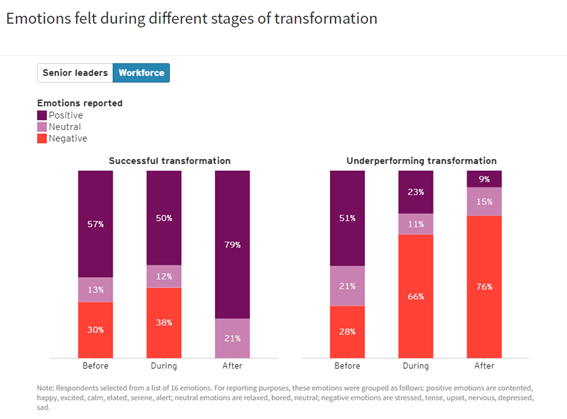Nowadays, disruption is one of the few constants of the business world – and disruption can come from various sources: new business models, new customer needs and demands, changes across industry value chains, technology evolution… the list goes on. Companies must therefore be prepared to identify and assess changes in an agile way and to adapt and respond at an ever-quickening pace to those changes.
Over the last few years, there has been a shift in the nature and speed of transformation. According to the 2021 EY Global Board Risk Survey, 82% of board members and CEOs feel that market disruptions have become more frequent and impactful. To keep pace, companies have begun to transform more frequently, whether that entails changes in leadership and staff, supply chain reorganization, or mergers and acquisitions.
Initiatives related to business transformation are not all created equal, however. They must be thoughtfully designed and successfully executed if they are to have an impact, and this requires an integrated and holistic approach that brings the company and the people within that company from vision to action. What is particularly key in this process of transforming a company is the corresponding personal transformation of its leaders.
When we consider how these two processes – that of business and behavioral change – are linked, a new paradigm arises, what I regard as holistic transformation that goes after the mind, heart, and body of a company.
Mindset Transformation: Purpose and Vision-Driven
Of course, any transformation demands a look to the future, and this reflection involves a creative process in which multiple potential future states are imagined for the company. This envisioning of the future can help craft a bold vision for the transformation and serve as a North Star throughout the journey.
It is a dynamic state. Nowadays, not putting enough focus and energy on defining and articulating a compelling vision for a company may represent the difference between success and failure in a transformation. Visionary leaders are those who reinforce and attend to the definition and execution process. Research from Oxford University and EY, finds that nearly half (47%) of respondents in a high-performing transformation said the vision was clear and compelling versus 26% of those in a low-performing transformation.
According to Oleg Konovalov, author of The Vision Code, there are certain criteria for a strong vision. All criteria are linked, each indispensable:
- Stimulus: A vision is created for others so it is important to consider who will benefit from it and how it will improve their lives.
- Scale: It is critical for a vision to evolve and continue adding value. Thus, leaders must reflect on how it can expand (geographically, in reach, etc.) and develop over time.
- Spotlight: A stated vision denotes responsibility for a cause or future, often for people and leaders have a duty to use this focus for the better good.
- Scanning: Visionary leaders are always watchful – in a way that others are not – of the industry trends and pressure points of the business, and in this way, they keep the company vision on track.
- Simplicity: Any strong vision should have the capacity to be explained and easily understood in less than two minutes (regardless of its complexity.)
- Excitement & Passion: There is nothing quite like the power of emotion and a successful vision will excite and inspire.
According to the World Economic Forum, more than 20% of workers were thinking of quitting their jobs in 2022. This percentage may be even higher for management and executive positions. Great resignation is not over. Many executives are likely exhausted, always going from one goal to the next, always looking for actions to achieve benchmarks and personal ambitions, faster and faster. Then suddenly, one day, they might start thinking about the purpose of their work, and what really deserves their time, energy, and will. It may be the case for some that there is no alignment between their aspirations, ambitions, and actions.
Of course, it is not unusual to experience this lack of alignment at different stages of one’s professional career. Nevertheless, it is certainly not ideal. Marshall Goldsmith, an executive coach and most recently the author of The Earned Life: Lose Regret Choose Fufillment, warns that when our actions are not aligned with our ambitions or our aspirations, we run the risk of wasting time and spinning our wheels in a way that might prevent us from ever arriving at our chosen destination.
Technology isn’t the vision in and of itself, but it does bring the vision to life.
Purpose and meaning have a payoff for both individuals and companies. Companies need conscious and purpose-oriented leaders to steer the business’s transformation initiatives, leaders with a high level of self-knowledge and whose ambitions align with their actions within the company. Thus, leaders need a long-term perspective when defining their personal vision and the underlying values they care about most, and should periodically fine-tune this vision – just as they periodically fine-tune the vision of the company or transformation initiative. It is important for leaders to be comfortable with regularly reflecting on how their personal vision aligns with that of the company. The higher the alignment the stronger the outcome.
Heartset Transformation: People at the Center
Business transformations generate profound changes, including in people’s attitudes and mindsets – and in this way a business transformation has the power to shape how people will behave in the future. This is cultural change and it is a strong differentiating force for companies, complex to imitate, and with the ability to foster a competitive advantage when it is properly aligned with the strategy of a transformation. It is best done at the beginning of the journey.
Changes are usually uncomfortable and change within an organization will have a direct impact on employees and their emotions. During transformation, people usually express that they feel more stressed, tense, upset, nervous, depressed, and sad. Overall, these negative emotions in the workforce increased by 25% during a successful transformation. This is an increase, yes, but compare that to the more than 130% increase that occurs during an underperforming transformation.
Source: The future of transformation is human, EY report (2022)
In this context, it is easy to understand why leaders need to be emotionally intelligent and able to recognize and regulate their own emotions, as well as the emotions of others. This includes a culture of belonging that focuses on employee engagement and motivates workers to stay with the company for the long term.
An attribute of this type of corporate culture is an increased sense of trust that comes with more inclusive and empathetic behavior. This starts with the members of the leadership team, who serve as role models for the organization and understand the relevance of training and developing coaching skills (e.g. deep listening, asking powerful questions, framing support, articulation of “what is going” behind the scenes, using intuition with no attachment, etc.)
In this way, empathetic leaders generate inclusive work environments with higher psychological safety and lower stress levels among employees, empowering employees to bring their authentic selves to work. This will empower teams to take risks and experiment with innovation, actively acting to improve connection and collaboration.
More and more organizations are using coaching to unleash their employee’s potential, increase employee commitment, and positively impact the company’s bottom line. According to BetterUp research, employees of companies with a high coaching culture are 20% more likely to report being able to recover quickly after stressful experiences and 18% are more confident in their ability to contextualize and reframe their thinking.
Body Transformation: The Execution Engine
Being able to execute a transformation in an agile way will allow any organization to learn from a more frequent cadence of feedback loops. A feedback loop is an iteration of execution time followed by a feedback process to understand what has worked well and what can be improved. Then, this repetition process continues with the next feedback loop (execution plus feedback) to learn and adapt faster.
The pace of innovation these days means that companies must constantly work to differentiate themselves and their offerings from their competitors to succeed. This means that there is no time to wait: a company must develop its capabilities through the various stages of the transformation process. Today, many of those capabilities are related to technology and digital competencies. Technology isn’t the vision in and of itself, but it does bring the vision to life and the right technology can help leaders fulfill the vision while facilitating the process of transformation.
In fact, the effective use of technology is one of the main drivers of success in transformations According to EY research, incremental enhancements in leading practices around investment and agile deployment of the right technology, having the right skills and mindset can improve the average likelihood of success of transformation programs by 25%.
In this context, leaders would do well to prioritize progress over perfection. It’s important to prove the value of the new technology-enabled approaches from the beginning and to enlist early adopters and influencers to engage customers – and the workforce – in terms of realizing the company’s vision and value.
Thanks to technology, leaders have become better at delegating responsibilities, removing barriers, and empowering multi-functional teams to accelerate decision-making processes in a more autonomous and decentralized manner.
New contexts require a different approach to business transformation, one that is integrated with the personal transformation of its leaders. A paradigm where the mind, heart, and body of the organization are aligned and serve together in achieving a unified and shared vision, where the leaders of the organization find the meaning and purpose necessary to unleash potential –their own and that of their employees – at work.
© IE Insights.












